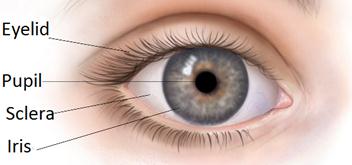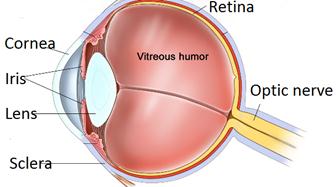
CATEGORIES:
BiologyChemistryConstructionCultureEcologyEconomyElectronicsFinanceGeographyHistoryInformaticsLawMathematicsMechanicsMedicineOtherPedagogyPhilosophyPhysicsPolicyPsychologySociologySportTourism
III. Reading
1) Study the diagram of an eye and find Ukrainian equivalents for the parts of the eye from the list below
Ðîãîâà îáîëîíêà Çîðîâèé íåðâ dzíèöÿ Ñêëåðà Ïîâ³êà Ðàéäóæíà îáîëîíêà Êðèøòàëèê ѳò÷àñòà îáîëîíêà
Determination of Eye Colour
The iris (a word that comes from the Latin rainbow) is one of the most readily observable parts of the eye. This article is about different eye colours caused by the difference in iris structure. Structure of the iris. The iris is made up of four layers - The anterior border layer (the front layer facing out) - The stroma - Two layers of endothelium (at the back of the iris) The double layer is responsible for dilating the pupil and absorbing any stray light that reaches the back of the iris. It is only the first two layers that determine iris colour. The anterior border layer contains melanocytes. Everyone’s body contains about the same number of melanocytes, but the amount of melanin in these cells is genetically determined. Melanin absorbs light and is the principle pigment in hair and skin. Differing levels of melanin account for the differences in skin and hair colour between races and individuals. People with dark skin and hair have a generally higher level of melanin than pale, blond people. As a result, people with darker skin and/or hair are more likely to have brown eyes. In the eye, low levels of melanin absorb less light and have a yellow appearance. While high levels look brown. The stroma is a connective tissue layer which contains collagen, blood vessels and the iris sphincter. The iris sphincter is the muscle which constricts the pupil. While light entering the stroma is scattered by the collagen. The collagen absorbs most of the colours apart from blue or grey, these are reflected back by the collagen. The blood vessels and sphincter scatter the light in different ways giving different patterns of flecks. The ring that can sometimes be seen in the iris is the minor iridic circle, which is the artery ring supplying the iris with blood. Freckles and darker patches on the iris are caused by round groups of pigment and are called clump cells. Whether the eye is blue or grey depends on the arrangement of the collagen fibres, fine arrangement causes blue eyes while a coarser arrangement causes grey ones. Different Eye Colours. In a brown eye there is a lot of melanin in the anterior border layer. This absorbs the light and gives a brown velvety appearance. In a blue eye there is not much melanin in the anterior border layer. The light passes into the stroma where the collagen fibres scatter the light back as blue. In a green eye (or a hazel one) there is a variable level of melanin, so that some of the light is absorbed by the melanin and some is scattered by the collagen. The brown layer looks yellow as it is thinner, and so the yellow and blue mix to make green. Red eyes are a result of albinism. Albinism is where there is no melanin in the melanocytes at all. Therefore all of the blood vessels (in the iris and retina) are seen and a redder appearance is given. In practice only very few albinos have red eyes, the blue reflections of the collagen show up stronger and so most have blue/grey or even brown. The mixing of red and blue reflections can also give rise to violet eyes. Genetic Inheritance Like many human characteristics, eye colour is determined at least partially by genetics. This is where your parents’ characteristics are passed onto you and your siblings via your genes. As with most genes, people have two copies of the gene controlling eye-colour (one from each parent). You only need one copy turned ‘on’ to make enough melanin to have brown eyes. Obviously the same applies to your parents, so a brown-eyed parent could have one or two ‘on’ copies, but a blue-eyed one must have two ‘off’ genes. So, if your father has brown eyes, he might have both genes turned ‘on’, or just one. If he gives you an ‘on’ copy, then you will have brown eyes, whatever colour your mother has. The same applies to your mother. If she gives you an ‘on’ copy then your eyes will be brown. If you get an ‘on’ copy from each parent then your children’s eyes will be brown too. You can still get blue eyes from two brown-eyed parents, but only if they both have one ‘on’ and one ‘off’ copy and they both give their ‘off’ copy to you. If this were the case, you should have three brown-eyed siblings for every blue-eyed one (although you would need a lot of brothers and sisters to test this). However it isn’t as easy as that. There is more than one gene controlling eye colour, allowing for various degrees of pigmentation.
2) Decide if the statements are true or false, make necessary corrections in the statements you think are false.
1) Different eye colours are caused by the difference in stroma structure. 2) The iris is made up of three layers. 3) People have different skin and hair colour because of differing levels of melanin. 4) In the eye, low levels of melanin have a brown appearance. 5) The collagen does not absorb blue or grey. 6) The stroma is a connective tissue layer which contains collagen, and the iris sphincter. 7) All albinos have red eyes. 8) Violet eyes do not exist. 9) Like many human characteristics, eye colour is determined completely by genetics. 10) You can not get blue eyes from two brown-eyed parents. 11) Two genes control eye colour, allowing for various degrees of pigmentation.
Date: 2014-12-28; view: 1122
|

